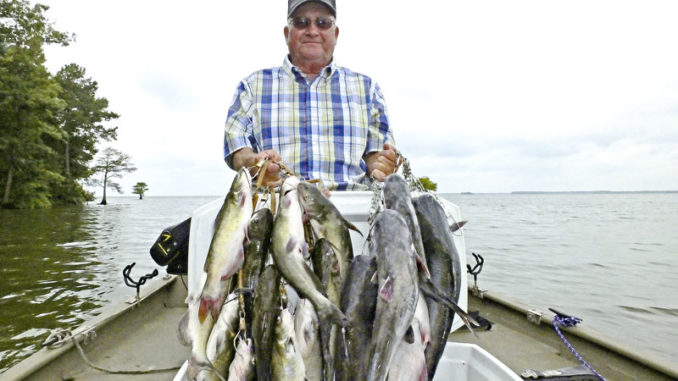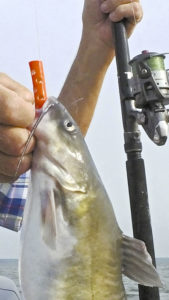
Fishery for channels is still top-drawer, especially in summer’s hottest weather.
Long before blue and flathead catfish arrived on the Santee Cooper fishing scene, the two lakes were teeming with big channel catfish. The system’s fertile waters allowed these fish to grow to gargantuan sizes. The world-record channel catfish, 58 pounds from Lake Moultrie in 1964, still stands.
When blues and flatheads were introduced in the mid-1960s the baseline for a shift in catfish dynamics was set in motion.
Fast-forward two decades, and the Santee Cooper system was consistently producing huge blues and flatheads. And they were available in vast numbers.
The majority of catfish anglers thought bigger was better. So the channel catfish slid into relative obscurity for many.
Overlooked?
Chad Holbrook, a former fisheries biologist for the S.C. Department of Natural Resources who oversaw the Santee Cooper lakes, said it’s totally understandable that blues and flatheads became immensely popular.
“The fast growth and top-end size of blues and flatheads, along with the channel catfish record, demonstrate the system is apparently ideal for growing big catfish,” Holbrook said.
Biological data dates to 1985, he said. And it verifies what many anglers know: the channel catfish was, and still is, a thriving fishery.
“I’d classify the population as very healthy, with basically the same channel catfish population now as in 1985,” he said. “But the top-end size seems to have diminished, likely because of competition with blue catfish.”
Holbrook said blues have the genetic potential to grow much larger than channels. And big blues apparently out-compete channels for top-end catfish forage.
“But the channel catfish fishery is excellent, and while many fish caught are in the 2- to 5-pound class, our netting samples indicate 10- to 12- pound channel catfish are doing well. We know the occasional 20-pound channel catfish is caught. The channel catfish population could actually handle more fishing pressure than it is currently receiving.”
Channeling Heat
A core group of channel catfish enthusiasts utilize this fishery during the hot-weather months.
One is Bill Geddings, a veteran angler from Lane, S.C. Geddings grew up fishing Lake Marion and Lake Moultrie and targeting channel catfish long before blues and flatheads were introduced.
“I love to catch big catfish, just like anyone,” Geddings said. “But in the summer, the channel catfishing is exceptional. I’ve found the key to consistent success is a combination of the right bait and place to fish.”
Geddings said one productive spot in August is the Diversion Canal. With good current flow excellent, fishing for channel cats is great in the 7-mile-long canal that connects the two lakes.
“The popular method is drift-fishing, and most fishermen bounce a weight on the bottom with a leader line, hook and bait about a foot above it,” he said. “Many baits produce good results, including night crawlers, minnows, catalpa worms and small chunks of cut bait.”
Geddings prefers another method that catches even more fish.

Stinky Alternative
“Fishing stinkbait is a killer technique for hooking lots of channel cats,” he said. “It’s my favorite technique. We’ll often have multiple fish hooked.
Even with three people fishing eight rigs, sometimes we can’t keep up with the bites. It’s not unusual to have all the rigs lying in the boat with catfish flopping all over the floor when the bite is on.
“That’s one problem I like,” he said. “We’ll unhook fish, bait the rigs and get them back in action,” he said. “When the action is this good, I don’t put all the rigs back out. Managing one can be a challenge; two just creates chaos.”
The aptly named stinkbaits excel at attracting channel catfish, whose celebrated sense of smell lures them to the gooey concoction slathered on a treble hook or extra-long shank single hook. A long list of stinkbaits is available, but Geddings’ favorite is Doc’s Catfish Getter Dip Bait.
Commercial rigs to hold stinkbait are available. A small piece of sponge with a hook embedded will soak in and hold the goo.
“I find channel catfish on shallow flats, points or humps in 4 to 8 feet of water,” he said. “But deeper water nearby is a key, and I prefer a firm bottom, with sand or gravel, over soft or muddy. Channel catfish tend to forage in shallow water during low-light times, and in the mid-day sun, they often retreat to nearby deeper water.”
Geddings said a side benefit is blue catfish in the 3- to 7-pound class often bite the stinkbait, adding to the catfish tally at day’s end.
“On light or medium tackle, channel catfish provide a great fight and are prime size for eating,” he said. “For fast action throughout the summer, I love Santee Cooper channel catfish. And be sure to take plenty of bait and a big cooler.”
Click here to read about fishing for High Rock Lake’s channel catfish.

